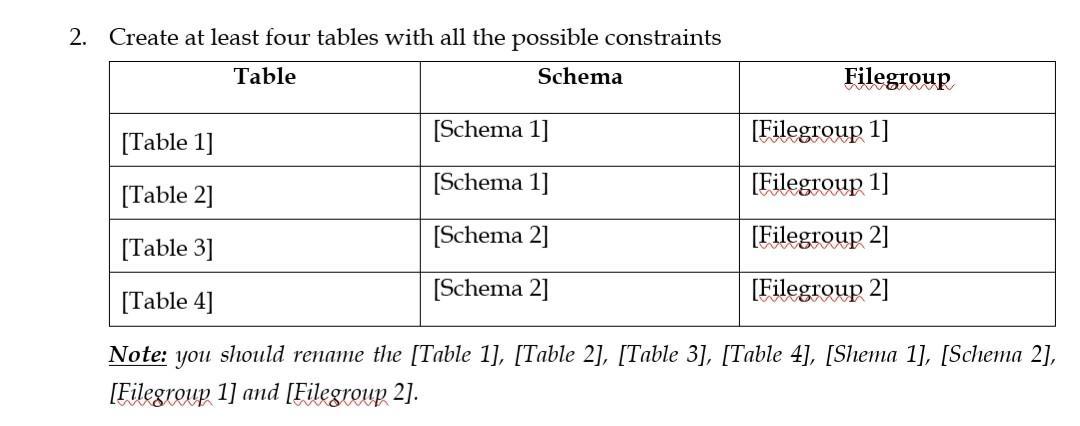Question
CREATE DATABASE MyDB ON PRIMARY ( NAME='MyDB_Primary', FILENAME= 'DMyDB', SIZE=50MB, MAXSIZE=unlimited, FILEGROWTH=10MB), FILEGROUP MyDB_FG1 ( NAME = 'MyDB_FG1_Dat1', FILENAME= 'D:MyDB', SIZE=50MB, FILEGROWTH=10MB), FILEGROUP MyDB_FG2 (

CREATE DATABASE MyDB ON PRIMARY ( NAME='MyDB_Primary', FILENAME= 'D"\MyDB\', SIZE=50MB, MAXSIZE=unlimited, FILEGROWTH=10MB), FILEGROUP MyDB_FG1 ( NAME = 'MyDB_FG1_Dat1', FILENAME= 'D:\MyDB\', SIZE=50MB, FILEGROWTH=10MB),
FILEGROUP MyDB_FG2 ( NAME = 'MyDB_FG2_Dat1', FILENAME= 'D:\MyDB\', SIZE=50MB, FILEGROWTH=10MB), ( NAME = 'MyDB_FG2_Dat2', FILENAME= 'D:\MyDB\', SIZE=50MB, FILEGROWTH=10MB),
LOG ON ( NAME='MyDB_log', FILENAME= 'D"\MyDB\MyDB_log', SIZE=15MB, FILEGROWTH=5MB), GO ALTER DATABASE MyDB MODIFY FILEGROUP MyDB_FG1 DEFAULT; GO
-- Create a table in the user-defined filegroup. USE MyDB; CREATE TABLE MyTable ( cola int PRIMARY KEY, colb char(8) ) ON MyDB_FG1; GO
2. Create at least four tables with all the possible constraints Table Schema Filegroup [Table 1] [Schema 1] [Filegroup 1] [Table 2] [Schema 1] [Filegroup 1] [Table 3] [Schema 2] [Filegroup 2] [Schema 2] [Table 4] [Filegroup 2] Note: you should rename the [Table 1], [Table 2), [Table 3], [Table 4], [Shema 1], [Schema 2], [Filegroup 1] and [Filegroup 2]Step by Step Solution
There are 3 Steps involved in it
Step: 1

Get Instant Access to Expert-Tailored Solutions
See step-by-step solutions with expert insights and AI powered tools for academic success
Step: 2

Step: 3

Ace Your Homework with AI
Get the answers you need in no time with our AI-driven, step-by-step assistance
Get Started


